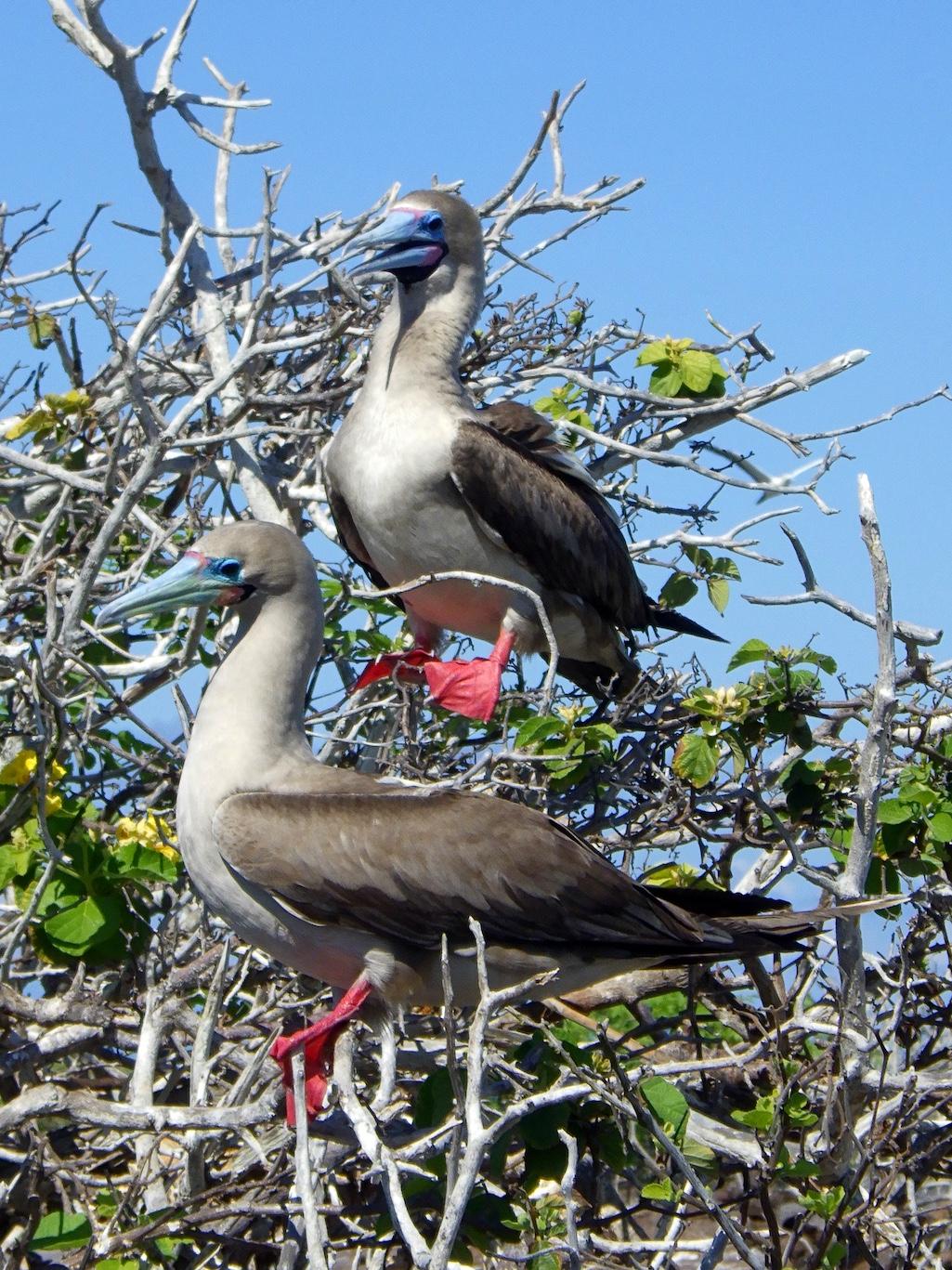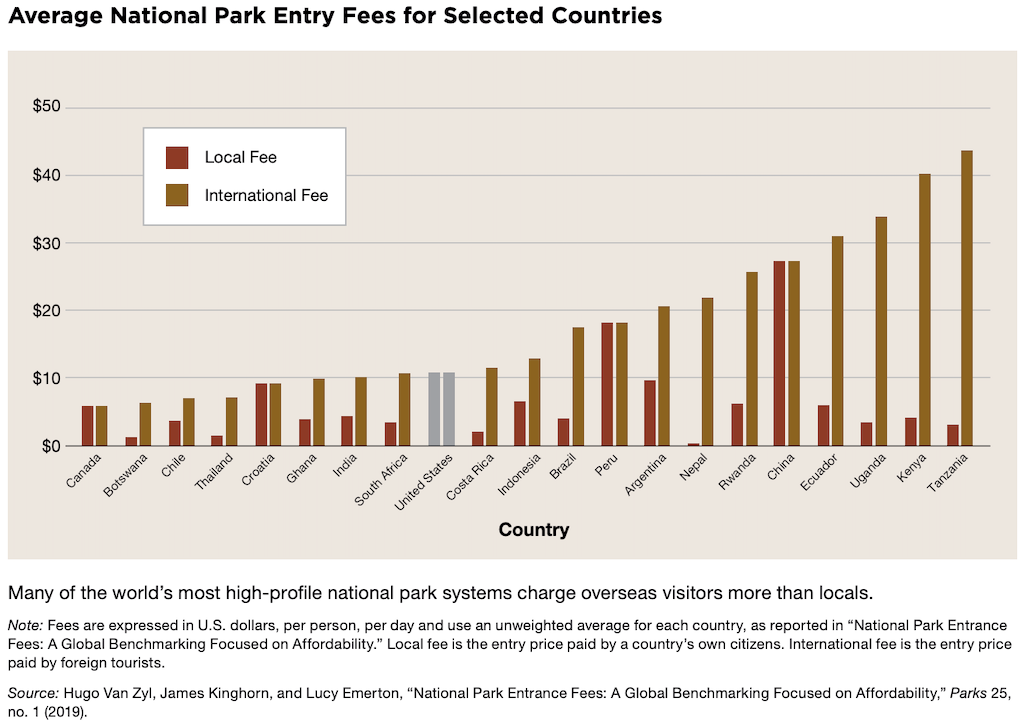
A $100 fee was well worth it to stand in front of red-footed boobies in Galapagos National Park. Would foreign visitors balk at a surcharge to walk the boardwalk around Grand Prismatic Spring or gaze into the Grand Canyon?/Kurt Repanshek file
When my wife and I visited Galapagos National Park last spring, it was the trip of a lifetime and we didn't think twice about the $100 per person park entrance fee. Indeed, it was a tiny sliver of the trip's overall cost. Ecuadorian residents, meanwhile, are charged a $6 entrance fee, a vast difference that raises the question of whether the National Park Service needs to place a surcharge on international visitors?
At the Property and Environment Research Center, a Bozeman, Montana, nonprofit that advocates for free market solutions to public lands issues, research fellow Tate Watkins argues that the Park Service is being deprived of hundreds of millions of dollars each year by not charging foreign visitors more to enter parks.
In a report released just before the holidays, Watkins said the Park Service could see an additional $330 million simply by placing a $25 surcharge on the roughly 14 million international visitors who visit U.S. parks.
"Crucially, this additional revenue would be dedicated to maintaining ailing parks and improving stewardship of them," wrote Watkins. "The majority of park fee receipts are retained and spent where collected, as superintendents and on-the-ground staff see fit. The model empowers local managers who best know their parks—and the needs they face—to decide how to spend funds. Ultimately, additional fee revenue would help ensure all visitors can continue to enjoy an incredible experience at U.S. parks."
It's no secret that the Park Service is strapped for funding. The backlog of maintenance in the National Park System has been estimated at $22 billion; there are staffing shortages, in part because of low pay; and the steady addition of new units to the park system brings new costs to the agency.
While fee increases to enter parks or to camp in one routinely draw complaints from the public, the fees are a bargain for the access they provide. Two years ago, in a video produced by PERC, Yellowstone National Park Superintendent Cam Sholly pointed out that a $35 fee for a family of four to spend 3.2 days (the average stay) in the park works out to $2.89 per person per day. At the same time, it cost a family of four $122 to visit the Space Needle in Seattle, while a trip to Disney World in Florida cost $110 per person per day, according to PERC.

While a big jump in domestic entrance fees — say, a doubling or tripling — isn't likely because of strong opposition from some members of Congress, gateway communities, and even attorneys general, PERC believes one on foreign visitors is appropriate and wouldn't cause a backlash.
"Asking international tourists who do not support U.S. national parks through taxes to pay a little more to see them is not only reasonable, it would also provide additional resources to improve the stewardship of our 'crown jewels,'” Watkins stressed in his report. "Moreover, formal evidence suggests that demand to visit U.S. national parks—in particular the highest profile destinations—is not sensitive to admission prices, particularly for overseas visitors."
While Watkins is of the opinion that the Federal Lands Recreation Enhancement Act gives superintendents leeway in setting fees, he said Congress should specifically "encourage parks to adopt a surcharge on international visitation..."
Though checking each visitor's nationality could create long lines at park entrance stations, the PERC researcher suggests that international visitors be given the option of paying the surcharge electronically in advance of their trip to the United States or that parks "leave collection or enforcement of the surcharge to some point beyond physical gates, similar to how some state parks check passes in parking or other areas."
"Relatedly, the fact that many international tourists visit national parks via tour buses could make implementation simple if it allows for coordination of payment with or even remittance of fees from commercial operators," he added.
In concluding his argument for a foreign visitor surcharge, Watkins pointed out that, "[D]ozens of countries around the world have set the precedent of charging foreign tourists more to visit national parks than citizens. Adopting the approach in the United States would provide much-needed funding to make sure the U.S. park system can be sustained for visitors of all types for generations to come."



Comments
I remember in 1986 when the NPS raised entrance fees in large parks such as Yellowstone/Grand Teton to $5. Per the U.S. Inflation rate that's equal to $14 in 2024 dollars. So, the current $35 entrance fee is twice that of the rate of U.S. inflation. Add to that the takeover of camping fee mgmt via Recreation.gov by the for-profit entity of Booz Allen Hamilton, and we're slowly eroding away the unaffordability of NPS sites for all visitors (foreign and U.S citizens). And, Cam Sholly's drumming up of the same old message about what a deal the NPS is compared to Disney World is like comparing apples and oranges. He's welcome to raise that comparison once we start builiding amusement park rides in Yellowstone.
Welcome to your private public parks. Payment will be via app on your smart phone.
This is obvious to anyone willing to open their eyes
Having moved to the US five years ago and having visted numerous national parks since then, I've always felt that the typical $35 entrance fee seemed extremely cheap for the value of the experience that it provides. Too cheap.
I've 'upgraded' to the annual pass also. The $85 or so for that is great and efficient, but after various more park vists it actually feels like I'm stealing or at least underpaying for what I'm getting. Hell, I want NPS staff to be paid reasonable and livable wages.
Given that American culture fosters relutance and hessistance to properly fund essential government services, I feel that entrance fees for actual users (visitors) should be way higher.
$80 for the 7 day park entrance
$250 for the annual pass
Yes. They should be charged more.
Very interesting article. As a retired Ranger, I want everyone to be able to experience the parks, and hate that money is a barrier to many. But when we were in India, and went to the Taj Mahal, we paid significantly more that the Indians paid. I think about that trip often, but until today, I'm not sure I ever thought about that additional charge again. Having traveled internationally, I'm a very lucky guy. I'm always up for a bargain, but would much rather see my money go towards protecting a place (and paying a living wage to those who protect a place) than I would seeing that money line corporate pockets. If this were to happen, though, I'd want see more US taxpayers benefit in lower entrance fees, and I'd want to ensure that Yucca House got a share of the money brought in at Yellowstone, and that Aztec Ruins got a share of what came in at Acadia. Fairness to all 428 parks is crucial.
I don't like the idea. Parks Canada doesn't have any additional fees for foreign nationals. Their annual passes are sold at the same price and their website specifically notes shipping to the United States, China, Taiwan, etc.
As far as I know, the only case where US federal lands have a different fee structure or eligibility is for the interagency senior and disabled passes, which are only available to US nationals (I throw in American Samoans) and US permanent residents, although when my parents got theirs or used their passes nobody asked for proof of eligibility.
Yes, we should charge non-residents and non-citizens more money to visit our parks. Gobs of foreign visitors exiting their mammoth tour busses in Yellowstone should be enough to convince any conservationist that they need to pay more if for no other reason than their disparate impact on our parks.
State parks routinely charge out-of-state visitors plenty more to enter and to camp (and fish and hunt), why not on the federal level?
Agree that fees to visit national parks should be higher across the spectrum, and especially higher for non-citizens.
Bussloades seem to have a disparate impact on the parks - those tourists will pay the money, as they already have a significant investment in the trip!